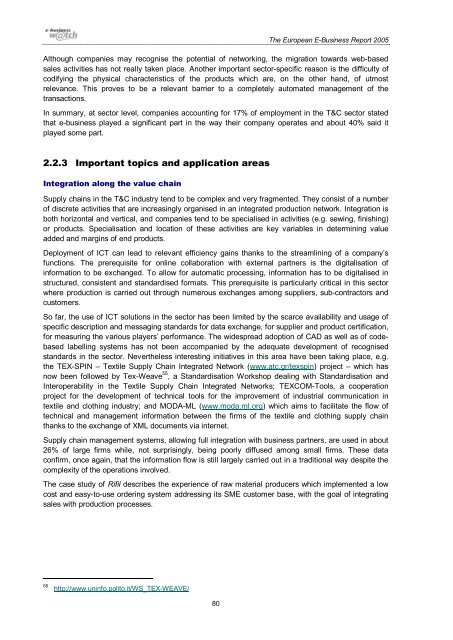The European e-Business Report The European e ... - empirica
The European e-Business Report The European e ... - empirica
The European e-Business Report The European e ... - empirica
Create successful ePaper yourself
Turn your PDF publications into a flip-book with our unique Google optimized e-Paper software.
<strong>The</strong> <strong>European</strong> E-<strong>Business</strong> <strong>Report</strong> 2005<br />
Although companies may recognise the potential of networking, the migration towards web-based<br />
sales activities has not really taken place. Another important sector-specific reason is the difficulty of<br />
codifying the physical characteristics of the products which are, on the other hand, of utmost<br />
relevance. This proves to be a relevant barrier to a completely automated management of the<br />
transactions.<br />
In summary, at sector level, companies accounting for 17% of employment in the T&C sector stated<br />
that e-business played a significant part in the way their company operates and about 40% said it<br />
played some part.<br />
2.2.3 Important topics and application areas<br />
Integration along the value chain<br />
Supply chains in the T&C industry tend to be complex and very fragmented. <strong>The</strong>y consist of a number<br />
of discrete activities that are increasingly organised in an integrated production network. Integration is<br />
both horizontal and vertical, and companies tend to be specialised in activities (e.g. sewing, finishing)<br />
or products. Specialisation and location of these activities are key variables in determining value<br />
added and margins of end products.<br />
Deployment of ICT can lead to relevant efficiency gains thanks to the streamlining of a company’s<br />
functions. <strong>The</strong> prerequisite for online collaboration with external partners is the digitalisation of<br />
information to be exchanged. To allow for automatic processing, information has to be digitalised in<br />
structured, consistent and standardised formats. This prerequisite is particularly critical in this sector<br />
where production is carried out through numerous exchanges among suppliers, sub-contractors and<br />
customers.<br />
So far, the use of ICT solutions in the sector has been limited by the scarce availability and usage of<br />
specific description and messaging standards for data exchange, for supplier and product certification,<br />
for measuring the various players’ performance. <strong>The</strong> widespread adoption of CAD as well as of codebased<br />
labelling systems has not been accompanied by the adequate development of recognised<br />
standards in the sector. Nevertheless interesting initiatives in this area have been taking place, e.g.<br />
the TEX-SPIN – Textile Supply Chain Integrated Network (www.atc.gr/texspin) project – which has<br />
now been followed by Tex-Weave 55 , a Standardisation Workshop dealing with Standardisation and<br />
Interoperability in the Textile Supply Chain Integrated Networks; TEXCOM-Tools, a cooperation<br />
project for the development of technical tools for the improvement of industrial communication in<br />
textile and clothing industry; and MODA-ML (www.moda.ml.org) which aims to facilitate the flow of<br />
technical and management information between the firms of the textile and clothing supply chain<br />
thanks to the exchange of XML documents via internet.<br />
Supply chain management systems, allowing full integration with business partners, are used in about<br />
26% of large firms while, not surprisingly, being poorly diffused among small firms. <strong>The</strong>se data<br />
confirm, once again, that the information flow is still largely carried out in a traditional way despite the<br />
complexity of the operations involved.<br />
<strong>The</strong> case study of Rifil describes the experience of raw material producers which implemented a low<br />
cost and easy-to-use ordering system addressing its SME customer base, with the goal of integrating<br />
sales with production processes.<br />
55<br />
http://www.uninfo.polito.it/WS_TEX-WEAVE/<br />
80

















